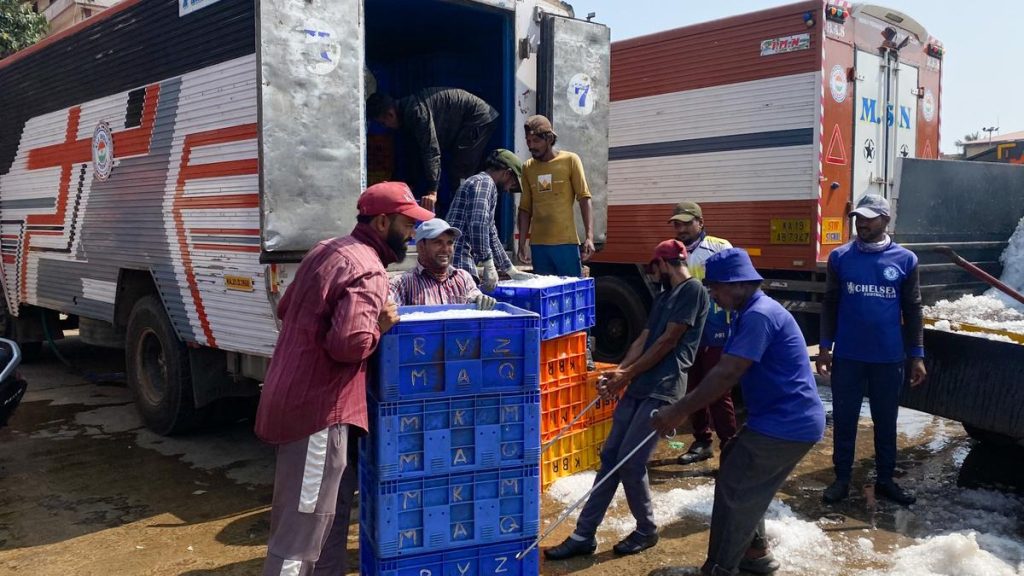The India Meteorological Department has emphasised the need to strengthen collaborative scientific efforts to develop a more precise weather forecasting system for the fisheries sector, a key export industry and vital for food security.
“The rising temperatures are taking a toll on both sea fishing and inland fisheries. With rice and wheat production expected to decline under the pressure of global warming, fisheries could serve as a crucial fallback for food security. To safeguard this sector, precise weather forecasting is essential,” said IMD Director General Mrutyunjay Mohapatra while addressing 38th annual day of ICAR-Central Institute of Freshwater Aquaculture, Bhubaneswar, on Tuesday.
Also Read | Cabinet approves new scheme for MSMEs in fisheries sector
Stating that there is rapid expansion of fishery ponds in coastal States marking paradigm shift in aquaculture, Mr. Mohapatra stressed on increased attention on the sector.
“Global temperatures are rising, with an average increase of 1.15 degree Celsius over the past century. In the polar regions, this rise is even more pronounced at 1.53 degree Celsius, while India’s landmass has warmed by 0.67 degree Celsius. As a tropical country, India experiences a stark contrast between maximum and minimum temperatures compared to polar regions. Its atmosphere is convective in nature, leading to an increase in extreme weather events such as cyclones, thunderstorms, hailstorms, and squalls,” he said.
“Fisherfolks are among the most affected by climate change due to their high exposure to these extreme conditions. Just as humans prefer cooler environments, fish thrive in cold water. However, with rising temperatures, the availability of cold water is diminishing. This warming trend directly impacts fish physiology, disrupting their natural regulatory processes,” said IMD DG.
Mr. Mohapatra said, “in search of colder habitats, fish are moving farther from the coast. Traditionally, fisherfolk relied on nearshore fishing, with the IMD providing forecasts up to 75 km offshore. However, as coastal fish populations decline due to rising temperatures, fishers are now venturing into deeper waters. To support them, authorities are identifying potential fishing zones.”
“Another concerning trend is the shift in rainfall patterns. While light and moderate rainfall benefits fishing communities, the frequency of heavy rainfall events is increasing. Excessive rainfall leads to higher runoff, reduced visibility, and greater water turbidity, all of which adversely impact fishing activities,” he said.
The light and moderate rainfall days are decreasing and heavy rainfall days are increasing. If it is light rainfall it is good for fishing communities. In heavy rainfall days, it will have more run-offs, less visibility and higher turbidity.
Emphasising on continuous observation and forecast for fishering sector, IMD DG said, “I can assure the IMD can give area and pond-cluster wise forecast. We can set up automated weather system at pond clusters. It will strengthen decision support system, which ultimately help farmers.”
Sharing on IMD’s experience with regards to agro-meteorological services for farmers, Mr. Mohapatra said, “India has 130 agro-climatic zones, and weather forecasts are developed in collaboration with the ICAR. Over time, the focus shifted from weather-crop relations to weather-pest dynamics, leading to the creation of crop-weather and pest-weather calendars based on historical data from ICAR institutes.”
“As crop-weather interactions evolved, district-level agro-meteorological services were introduced in 2008, followed by block-level services in 2021. The IMD, in partnership with ICRISAT, further refined its forecasts for block-specific crops. Farmers using these services in non-irrigated central Indian states gain an average of Rs. 12,000 more than those who don’t— a significant boost for those below the poverty line,” he pointed out.
“In addition to various mobile applications for weather forecasting, we have created a WhatsApp group to enhance outreach. Our goal is to connect at least five villagers from each village directly with IMD to ensure deeper penetration of agrometeorological services. By spreading weather updates through word of mouth, we aim to reach every farmer,” said IMD DG.
He further said, “We are also disseminating weather information to Sarpanchs, ward members, and panchayat secretaries through the Panchayati Raj Ministry. They receive updates in the local language, ensuring accessibility and effective communication.”
CIFA Director P. K. Sahoo deliberated on important achievements of institutes such as innovative technologies like smart pond, biofloc fish-rearing systems and portable hatcheries for scampi and pabda. Tej Pratap, Vice Chancellor of Sri Sri University, Cuttack, Sujay Rakshit, Director of Indian Institute of Agricultural Biotechnology, Ranchi and Arjamdutta Sarangi, Director of Indian Institute of Water Management, Bhubaneswar also spoke on the occasion.
Published – April 02, 2025 09:25 am IST


